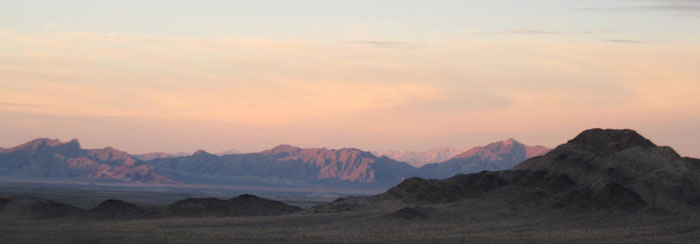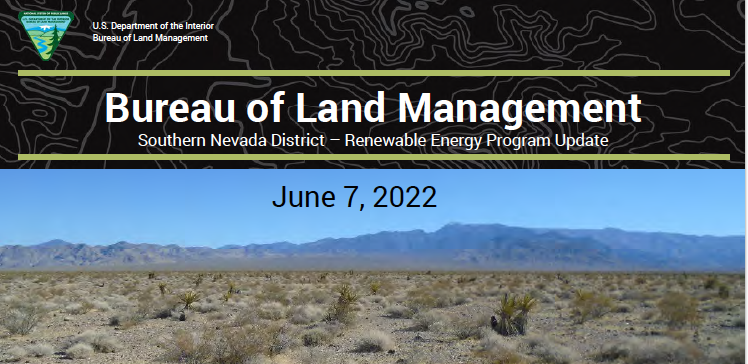Southern Nevada Renewable Energy Projects Update
June 9, 2022 - Las Vegas, NV - The Southern Nevada District of Bureau of Land Management released this slide deck in PDF form of a useful summary of all solar and wind applications in Clark County and Nye County south of Beatty. See the BLM Southern Nevada District Renewable Energy Program Update PDF.
Amargosa Valley Solar Projects
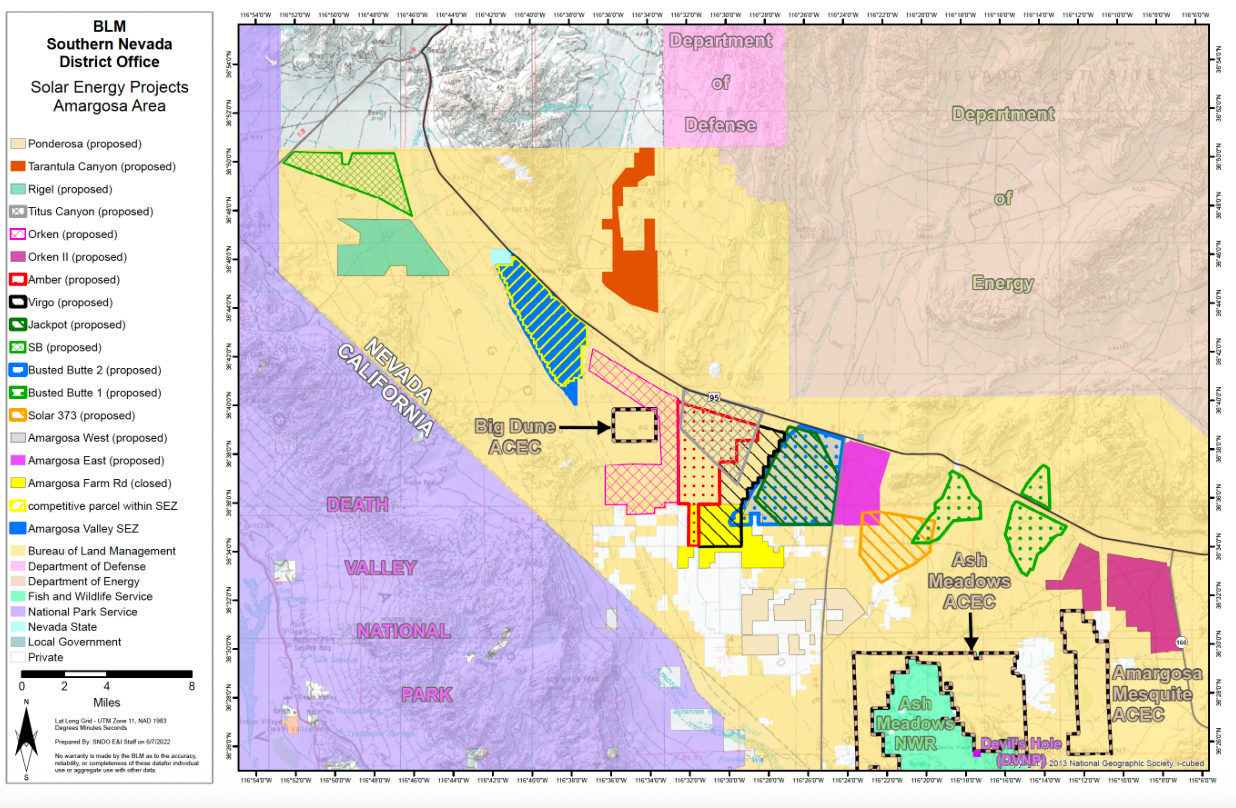
June 8, 2022 - Amargosa Valley, NV - The Bureau of Land Management Pahrump Field Office released a map (above) showing the huge number of solar applications filling up, and overlapping, in Amargosa Valley public lands. The original Amargosa Solar Energy Zone was supposed to be the place for solar energy development here, but solar developers have taken advantage of loopholes in the Variance process where they can apply for public lands outside of the Solar Energy Zone and still profit.
The solar applications spread from south of Beatty and the ghost town of Rhyolite, to Big Dune, and south to Lathrop Wells, Amargosa valley, and the borders of Asdh Meadows National Wildlife Refuge. The applications ignore recreation, dark night skies, Mojave Desert ecosystems, desert tortoise, groundwater concerns, dust, and communities where solar applications would abutt against private property. A large swath of the eastern edge of Death Valley National Park would be impacted with respect to viewsheds.
On a related note, you can comment on the Amargosa Solar Energy Zone leasing.
https://www.blm.gov/press-release/blm-seeks-comments-amargosa-valley-solar-energy-zone-leasing
BLM SEEKS COMMENTS ON AMARGOSA VALLEY SOLAR ENERGY ZONE LEASING
LAS VEGAS – The Bureau of Land Management is seeking public comment on an environmental analysis for leasing 7,232 acres of public lands within the Amargosa Valley Solar Energy Zone for solar energy development. The parcel of land is located approximately 45 miles northwest of Pahrump and 11 miles south of Beatty on the south side of U.S. Highway 95. The comment period will end June 17, 2022.
Advancing the environmental reviews for leasing within the Amargosa Valley Solar Energy Zone supports President Biden’s goal of creating a carbon pollution-free power sector by 2035, and to permit at least 25 gigawatts of solar, wind, and geothermal production on public lands by 2025.
“The Pahrump Field Office has received interest in solar energy development in the Amargosa Valley Solar Energy Zone spurred by the proposed Greenlink West Power Transmission line,” said Nicholas Pay, Pahrump Field Office Manager. “Solar Energy Zones, such as the Amargosa Valley Solar Energy Zone, are the BLM’s preferred location for utility-scale solar energy development. We look forward to the public’s comments on the environmental review for this Solar Energy Zone.”
The BLM manages public lands for many uses, including sustainable energy development. The BLM’s Solar and Wind Energy Rule, published in the Federal Register on December 19, 2016, reduces land and resource conflicts by incentivizing the development of solar projects in designated leasing areas, such as the Amargosa Valley Solar Energy Zone. The lease, if issued, would also contain terms, conditions, and stipulations to protect endangered species and cultural resources and ensure development is safe and environmentally responsible. After the parcel is leased, the lessee must submit a site-specific plan of development for additional environmental analysis before energy development can begin.
Comments that would be the most helpful during the review period are those that identify any new or changed circumstances that may affect the development of the Solar Energy Zone.
The Determination of NEPA Adequacy is on the BLM ePlanning project website at: https://eplanning.blm.gov/eplanning-ui/project/2019939/510. Written comments can be submitted by email to: BLM_NV_SND_EnergyProjects@blm.gov or by mail to: Bureau of Land Management, Pahrump Field Office, Attn: Energy & Infrastructure Team, 4701 N. Torrey Pines Dr., Las Vegas, NV 89130. Written comments will be accepted until 4:30 p.m. on June 17, 2022.
The BLM manages vast stretches of public lands that have the potential to make significant contributions to the nation’s renewable energy portfolio. To promote our clean energy goals, the BLM provides sites for environmentally sound development of renewable energy on public lands and new transmission routes to connect into the grid.
For additional information, please contact Beth Ransel at (702) 515-5000 or BLM_NV_SND_EnergyProjects@blm.gov.
Basin & Range Watch Sends Advising Letter to Sunshine Valley Solar
October 14, 2014 - Amargosa Valley NV - Basin & Range Watch retained an attorney to write a letter of advice to Sinshine Valley Solar LLC over the potential for Federally Endangered Yuma clapper rail "take" (mortality) on the proposed Sunshine Valley Solar Project in Amargosa Valley near the wetlands of Ash Meadows National Wildlife Refuge in Nye County NV. We believes it would be both prudent and legally appropriate for Sunshine Valley Solar to initiate the application process for an Incidental Take Permit.
The Yuma clapper rail (Rallus longirostris yumanensis) is a marsh bird listed as endangered under the Endangered Species Act. According to a July 2014 letter from the US Fish and Wildlife Service to Sunshine Valley Solar providing the agency’s comments on the Project, solar photovoltaic (“PV”) facilities like the Sunshine Valley Solar Project “present a new source of mortality for Yuma clapper rails” because “[t]hese facilities reflect light during the day and night, producing a lake or pond effect that may attract rail species and other water-associated birds.” Several rail bird mortalities caused by this “lake effect” at PV facilities have been documented, and the actual number of mortalities is likely higher than this documentation reflects, as scavengers often remove bird carcasses before they can be accounted for. See the letter >>here.
US Fish & Wildlife Service Says Yuma Clapper Rail Kill Likely for Solar Project
August 1, 2014 - Amargosa Valley NV - The US Fish and Wildlife Service (FWS) sent a letter dated July 11, 2014 to the Nevada Public Utilities Commission concerning the likely killing of a rare Yuma clapper rail which is federally endangered, at the 110 MW Sunshine Valley Solar Project on private land in Amargosa Valley. The proposed project would be 8 miles northwest of Ash Meadows National Wildlife Refuge where occupied marsh habitat exists. FWS said it beleives an incidental take of Yuma clapper rail is likely. At least one Yuma clapper rail has been found killed at the Desert Sunlight Solar Farm in Riverside County. FWS recommended that the parent company First Solar develop a Habitat Conservation Plan to support an application for an incidental take permit for Yuma clapper rail. Additionally the Service wants the developer to have a Bird and Bat Conservation Strategy to avoid, minimize, and mitigate deaths of birds under the Migratory Bird Treaty Act.
Ash Meadows National Wildlife Refuge and New Solar Projects in the Amargosa Desert
June 3, 2014 - Amargosa Valley, NV - A site visit to a photovoltaic proposal by First Solar, Sunshine Valley Solar Project, and comments about waterbird mortality by the lake-effect of photovoltaic and mirror projects >>here.
Solar Trust of America Files for Chapter 11
April 2, 2012 - See story >>here.
Amargosa Farm Road Project Dead for Now
November 19, 2011 - A 10% financer of the solar thermal project begun by Solar Millennium, Global Finance Corp., has turned to US District Court to stop a sale of majority owner Solar Trust of America Development (STA) to another company. Global Finance contends it has not had a chance to review transaction documents that could have a large bearing on Amargosa's future.
In a September 1 letter STA informed Global Finance managing director Donald Reid that it had put the project on hold in March.
According to the letter written by STA President Alice Harron, the fatal blow came March 7 when NV Energy rejected a proposal for a Power Purchase Agreement.
"STA has tried, without success, to identify other viable options for the development of the project ... to return it to active development," Harron wrote.
As a result, she declared the joint development agreement signed four years ago with Global Finance to be dead. Reid countered in subsequent correspondence that he still considers it alive.
The strain was pushed to the forefront when the German company solarhybrid AG began negotiations in October with Solar Millennium over buying the entire US project pipeline. STA is a subsidiary of Solar Millennium AG of Germany. Donald Reid is trying to halt this deal for fear that his 10 percent piece of Amargosa will be eliminated in the process.
http://www.lvrj.com/business/with-solar-plant-on-hold-lawsuits-start-134169293.html
Amargosa Farm Road Will be Redesigned to Photovoltaic
October 12, 2011 - The change comes as a result of the German company solarhybrid’s acquisition of Solar Millennium’s 2.25-gigawatt project portfolio in the American Southwest.
Originally designed as a concentrating solar power (CSP) project, the Amargosa Farm Road plant is expected online by 2014. Though the Nevada Public Utilities Commission had previously approved a power purchase agreement (PPA) with NV Energy, it is assumed that the PPA will need to be renegotiated considering the change in technology.
The project has been plagued by problems with water mitigation, flood control structures, and a lack of transmission. NV Energy may not want any more power from large renewable plants after saying it is on track to meeting its renewable goals, and California's Governor Brown has said his state does not expect to import much electricity from distant renewable power plants.
Other projects affected by the purchase of Solar Millennium include the 1-gigawatt Blythe project, the 500-megawatt Palen project, and the 242-megawatt Ridgecrest project.
http://www.greentechmedia.com/articles/read/Amargosa-Farm-Road-Switches-From-CSP-to-PV/
Solar Millennium Considers Switching Amargosa Farm Road Project to PV
August 25, 2011 - Solar Millennium AG may change the design of its solar thermal plants planned for the US, Manager Magazin reported, citing an unidentified company spokeswoman.
Erlangen, Germany-based Solar Millennium is considering switching plants in the Amargosa Valley near Las Vegas, and Palen in California to photovoltaic generation, the magazine said, citing the spokeswoman.
The company has already redesigned their Blythe Solar Power Project and Ridgecrest Solar Power Project from solar thermal parabolic trough to photovoltaic.
Amargosa Farm Road Project Converting to Photovoltaic?
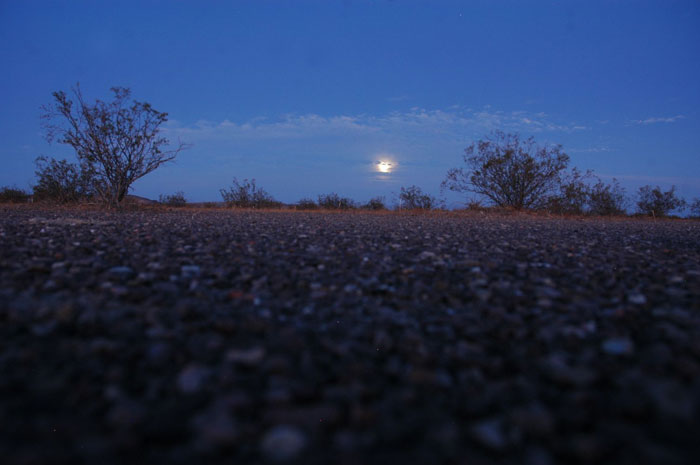
June 14, 2011 - Concentrating solar thermal power (CSP) plants are so expensive that the developers can not make it without federal subsidies. Many of these companies are converting their designs to cheaper photovoltaic (solar panels) plants. Solar Trust of America (Solar Millennium) has recently told the Bureau of Land Management that they are considering converting their 4,600 acre Amargosa Farm Road project in Nevada from CSP to photovoltaic.
See: US solar developers mix and match in search of an edge.
http://www.rechargenews.com/energy/solar/article260696.ece
Amargosa Farm Road Project Delayed Until 2012
April 5, 2011 - Primm, Nevada - At a meeting with Bureau of Land Management and stakeholders over large solar projects in Ivanpah Valley, Mark Spencer of the Pahrump BLM Field Office gave an update on Amargosa Valley projects.
- Solar Millennium's Amargosa Farm Road Project is slowing down. Even though they have been granted a Right-of-Way, the company said it will not go ahead with construction until 2012 due to administrative issues, the "large amount of paperwork." The company had hoped to begin this year.
- Abengoa's Lathrop Wells project is also slowing down and will not see construction any time soon.
- Pacific Solar needs an alternatives analysis, and will do a proposed Plan Amendment because the project would sit on top of a special recreation designation of the Big Dune off-road area. BLM will seek to change the land designation to accommodate Pacific Solar.
Kelly Langley, Supervisor, Centrally Assessed Unit of the Nevada Department of Assessment informed us that if a solar project takes the Nevada Tax Abatement they can take no other federal grants. This means the 30% grant from Federal Stimulus money is not available to the solar projects in Nevada. They must take one or the other.
Nevada Public Utilites Commission Approves
March 11, 2011 - The Public Utilities Commission approved a Utility Environmental Protection Act permit to Solar Millennium to construct two, 250-megawatt solar power plants at Amargosa Farm Road, in an order issued Feb. 14.
The UEPA is one of the key permits the company is required to obtain to build the project.
“That just tells us to make sure what permits we have to have before we pull a building permit for construction. We start making minor milestones,” said Billy Owens, the Solar Millennium director of project development.
http://pvtimes.com/news/public-utilities-commission-approves-solar-power-plant
Amargosa Farm Road Record of Decision
[Federal Register: November 22, 2010 (Volume 75, Number 224), Page 71144-71145, wais.access.gpo.gov]
DEPARTMENT OF THE INTERIOR
Bureau of Land Management
Notice of Availability of Record of Decision for the Solar Millennium, LLC, Amargosa Farm Road Solar Energy Project
SUMMARY: The Bureau of Land Management (BLM) announces the availability of the Record of Decision (ROD) for the Solar Millennium, LLC, Amargosa Farm Road Solar Energy Project Environmental Impact Statement (EIS). The Secretary of the Interior approved the ROD on November 15, 2010, which constitutes the final decision of the Department.
ADDRESSES: Copies of the ROD are available upon request from the BLM Southern Nevada District Office, 4701 N. Torrey Pines Drive, Las Vegas, Nevada 89130 or via the internet at the following Web site: http://www.blm.gov/nv/st/en/fo/lvfo.html. Copies of the ROD are also available for public inspection at the BLM Southern Nevada District Office and the BLM Nevada State Office, 1340 Financial Blvd., Reno, Nevada.
FOR FURTHER INFORMATION CONTACT: Gregory Helseth, Renewable Energy Project Manager; telephone: (702) 515-5173; mailing address: BLM Southern Nevada District Office, 4701 N. Torrey Pines Drive, Las Vegas, Nevada 89130; or e-mail: Gregory_Helseth@blm.gov.
SUPPLEMENTARY INFORMATION: The applicant, Solar Millennium, LLC, is authorized to construct the Amargosa Farm Road Solar Energy Project on approximately 6,320 acres of public land in 2 separate phases with a total generating capacity of approximately 500 megawatts (MW) of power. The Amargosa Farm Road Solar Energy Project is a solar facility utilizing parabolic trough solar thermal technology. Phase 1 of the project will generate 250-MW and Phase 2 will generate 250-MW, with an average net output of approximately 232-MW for each phase. Each phase will consist of power blocks, a solar field, a heat transfer fluid and steam generation system, a nitrate salt thermal storage system, conventional water treatment, electrical switchgear, administration, warehouse, and maintenance facilities.
The project facility will disturb approximately 4,350 acres of the 6,320 acre project area and will include solar fields, power blocks, office buildings, maintenance building, parking area, lay down area, storm water detention basin, evaporation ponds, switch yard, and a realignment of Amargosa Farm Road. The Notice of Availability (NOA) for the Draft EIS analyzing impacts of the proposed project was published in the Federal Register on March 19, 2010 (75 FR 13301) for public review and comment. A total of 37 comment letters were received on the Draft EIS. The comments were incorporated, where appropriate, to clarify the analysis presented in the Final EIS. The NOA for the Final EIS was published in the Federal Register on October 15, 2010 (75 FR 63503). The Final EIS analyzes 3 alternatives; a No Action Alternative, the Proposed Action, and a Wet-Cooled Alternative. These alternatives were shaped in part by comments received from the public and internal BLM review.
Alternative 1: No Action. The No Action Alternative assumes the right-of-way application for the Amargosa Farm Road Solar Energy Project would be denied and the proposed project would not be built.
Alternative 2: Proposed Action (Dry-Cooled). This is the Environmentally Preferable Alternative that analyzes the construction, operation, maintenance and decommissioning of 2 dry-cooled solar power plants, each with a nameplate capacity of 250-MW and a net output of
approximately 232-MW.
Alternative 3: Wet-Cooled Alternative. Under the wet-cooled alternative, the proponent would construct and operate 2 wet-cooled solar power plants, each with a nameplate capacity of 250-MW and a net output of approximately 242-MW.
Each solar plant would be equipped with thermal storage capability and associated linear facilities. Construction and operation of a wet-cooled project would be similar to a dry-cooled plant, however, the net power output from a wet-cooled solar power plant facility is greater than the net power output from a dry-cooled solar power plant facility. Plant components and layout are similar under both the wet- and dry-cooled alternatives; the primary differences are the amount of water used for plant operations, the need for cooling towers for heat rejection from the steam cycle for the wet-cooled alternative, and the area needed for evaporation ponds.
Because this decision is approved by the Secretary of the Interior, it is not subject to administrative appeal (43 CFR 4.410(a)(3)).
Salazar Signs Solar Millennium Amargosa Farm Road Project
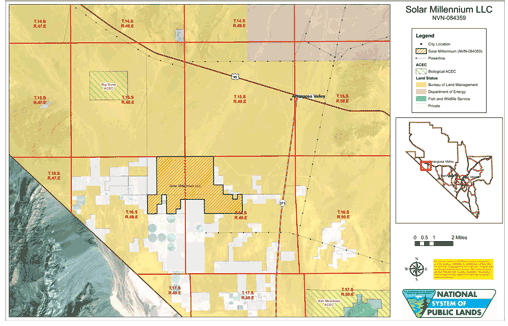
November 15, 2010 - WASHINGTON, DC – Secretary of the Interior Ken Salazar approved the second large-scale solar energy project ever on U.S. public lands in Nevada. When completed, the Amargosa Farm Road Solar Project, an initiative of Solar Millennium LLC, will be a 500-megawatt facility.
“This solar facility is yet another critical component in the Department’s growing renewable energy portfolio as we work to strengthen our nation’s energy security,” Secretary Salazar said in signing the Record of Decision for the project. “Our commitment to the development of clean, renewable energy is creating new jobs that will aid in our economic recovery, protect our environment and transform the way our nation gets our energy.”
“Development of solar, geothermal, wind and transmission line projects on our public lands demonstrates the Department and the BLM’s commitment to the production of renewable energy resources,” said BLM Director Bob Abbey. “These projects also exemplify the smart collaborative stakeholder partnerships we continue to develop to help us achieve our common goals to protect our natural environmental while utilizing America’s wealth of renewable energy resources.”
The Amargosa Farm Road Solar Project will employ concentrated solar power technology that will include two 250 megawatt parabolic trough, dry-cooled power plants equipped with thermal energy storage capability. The project will be located in the Amargosa Valley about 80 miles northwest of the town of Las Vegas, in Nye County, Nevada, on 4,350 acres of public lands managed by the Bureau of Land Management (BLM). The project has undergone extensive environmental review, starting with public scoping and followed by a draft environmental impact statement with full public involvement and a final Environmental Impact Statement published on October 15, which set the stage for a November 15 signing.
The BLM, U.S. Fish and Wildlife Service, and National Park Service worked closely with Solar Millennium to develop an "innovative water mitigation plan" that can serve as a model for future solar projects. The plan claims that the project will have a net neutral benefit on the plant and animal species found at nearby Ash Meadows National Wildlife Refuge and Devils Hole. But we note that in the Final Environmental Impact Statement, the exact locations of water rights to be retired or offset have not been determined yet.
Solar Millennium would be required to find and retire 236 acre-feet/year of groundwater. They still need to find a source for the construction (600 afy) and operation water (400 afy). In addition to dry-cooling towers, they will build a small wet-cooling auxilliary tower, which would slurp up 108 acre-feet/year, with a maximum of 197,500 gallons per day (Final EIS).
The BLM also worked with Solar Millennium to reduce the approved project footprint from 7,630 acres to 6,320 acres with a disturbance area of 4,350 acres. BLM will require a natural color palette and minimum night lighting measures to reduce visual impacts on the local community.
Through the American Recovery and Reinvestment Act’s incentives for specified energy programs, Solar Millennium would be eligible for approximately $1 billion in Investment Tax credits. The company is also eligible to apply for financing through the DOE Title 17 Loan Guarantee Program. The project is in negotiations to sell electricity to NV Energy under the terms of a power purchase agreement. The power will be supplied to the grid through Valley Electric Association, Inc.’s transmission lines.
Today’s announcement is part of the administration’s initiative to encourage the "rapid and responsible development" of renewable energy on U.S. public lands. Since early October, the Secretary has approved a total of eight large-scale solar energy projects, the first to be built on U.S. public lands in California and Nevada, that combined will generate 3,500 megawatts.
Last month, Salazar approved the first solar energy project on U.S. public lands in Nevada -- First Solar, Inc.’s Silver State North Solar Project, a 50 megawatt facility and associated infrastructure to be built in the Ivanpah Valley, 40 miles south of Las Vegas. In addition, on October 19, Salazar attended the groundbreaking of the One Nevada Transmission Line that will carry electrical power over a 235-mile system. When completed, the 500 kilovolt line will extend from north of Las Vegas, Nevada to Burley, Idaho, providing a critical link for the northern and southern power grids serving Nevada. The line will provide the transmission infrastructure needed to make proposed wind, solar and geothermal power generation projects throughout Nevada viable.
Reid Pushes Big Transmission to Help Big Solar
August 25, 2010 - Senator Harry Ried (D-NV) visited Pahrump, Nye County, touting how Nevada is on its way toward becoming energy independent within the next three years. Reid said on August 20 that NV Energy and LS Power agreed to jointly build and operate an energy transmission line between northern and southern Nevada. The Funding for the One Nevada Transmission Line comes from a provision Reid inserted into the American Recovery and Reinvestment Act.
“The only way to take full advantage of Nevada’s abundance of clean energy resources is to create a system that allows us to move that energy from the remote parts of our state where it is developed, to the population centers where it is needed,” he said.
Amargosa Farm Road Solar Project (Solar Millennium), and Abengoa's Lathrop Wells solar plant need new long transmission lines to ship power out of the valley, and this has been one of their largest challenges. Without new transmission, financing is hard to come by.
On Thursday, August 19, the Las Vegas Paiute Tribe signed a memorandum of understanding with Vally Electric Association that will allow the company to complete a 58-mile transmission line to Las Vegas. The tribe had earlier blocked passage of the line through their land.
See Pahrump Valley Times.
EPA Objects to Amargosa Farm Road Project
June 25, 2010 - The Environmental Protection Agency (EPA) released a letter dated May 17, 2010, commenting to Bureau of Land Management (BLM) on Solar Millennium's Amargosa Farm Road Project. The EPA reviewed BLM's Draft Environmental Impact Statement (DEIS) and found it "insufficient." EPA gave the document a rating of Environmental Objections, meaning there would be significant environmental impacts that should be avoided. "Corrective measures may involve substantial changes to the project."
EPA was particularly concerned about the large washes crossing the site, which they informally determined would qualify as a "waters of the U.S." and need special mitigation. Very little to no information or mapping was contained in the DEIS. They were also concerned about the impacts to groundwater in the Amargosa Valley, especially in the cumulative scenario of many other solar projects building nearby. Aquatic and riparian communities of Ash Meadows National Wildlife Refuge and Devil's Hole could be impacted.
The letter comments that BLM and Solar Millennium need to do a much more robust analysis of avoidance and mitigation measures, as well as find alternatives, including what EPA calls the Least Environmentally Damaging Practicable Alternative.
To download the EPA comment letter (2.6 MB pdf) click >>here.
BLM Opposes Solar Millennium's Water Application
The Bureau of Land Management has been trying to accomodate Solar Millennium, but in an interesting turn-around protested the solar company's water application with the Nevada State Engineer because Solar Millennium has refused to comply with BLM stipulations on environmental mitigation. Solar Millennium proposes to use 400 acre feet of water per year out of the Amargosa Valley Basin in Basin 230 for their Amargosa Farm Road project.
Recent Therminol Fires at Andasol, Spain
June 24, 2010 - Videos in Spanish show Therminol fires in Spain at the Andasol solar thermal power plants, which have molten salt storage and are similar in design to what is proposed in Amargosa Valley by Solar Millennium. Solar Millennium was involved in the design and engineering of the Andasol plants in Spain. ACS Cobra, a large Spanish construction company are now the owners and were the builders of the power block.
April 23, 2010 — Explosión planta termosolar Andasol (Granada):
http://www.youtube.com/watch?v=w7sTi99qTPE&NR=1
http://www.ideal.es/almeria/20091215/local/guadix/arde-placas-solares-andasol-200912152050.html
December 16, 2009 — Los bomberos de Guadix participan en la extinción de un incendio en la planta solar Andasol en el Marquesado del Zenete. El incendio provocó una espectacular columna de humo visible desde distintos puntos de la comarca y también desde la ciudad de Guadix. Bomberos y el servicio de la propia empresa emplearon una hora en controlar y extinguir el incendio.
http://www.youtube.com/watch?v=aGyvicfgZm0
See also: February 05, 2009 — Andasol Power plant in Spain 3x 50MW power plants with Nitrate and Potassium salt storage 7.5 hours after sun down or cloudy period full plant operation for each of the 50MW plants.
http://www.youtube.com/watch?v=bxCUYPzHsug&feature=related
Water Rights: State Engineer Decides
June 14, 2010 - Solar Millennium filed an application for a permit on March 17, 2010 by Amargosa Valley Solar 1 LLC to appropriate the waters of an underground source in Basin 230 in Nye County, Nevada. A new well would be drilled in a farm area, and would require a change of agriculture Irrigation Use to Solar Industrial Use. Solar Millennium would build a pipeline from the farm well to its Right-of-Way along an unspecified route. During a telephone conversation with Greg Helseth, Bureau of Land Management, Solar Millennium will lease 400 acre-feet per year (afy) for the power blocks and 200 acre-feet for other uses such as wash the mirrors and watering the roads. 400 acre-feet of water will irrigate 80 acres. There is no detail on how the 600 afy of construction water will be used during the construction period of two or three years. The permit application contains no conversion factor of irrigation use, which returns about 30% of the water back to the ground water, to industrial use, which will evaporate into the air.
Also, an additional 203 or more acre-feet of senior water rights north of Devil’s Hole will be purchased and held in trust for Nye County while Solar Millennium works out a plan with federal and state agencies. Once the agreements are made the water rights will be transferred to Nye County for future development.
But is using up the groundwater for solar projects in the best interest of the residents living in the deserts of Nevada whose very lives depend upon the water? Citizens may file protests of these water applications with the state engineer.
But a Nevada Revised Statute (NRS 533.372) may overthow citizens' rights. The State Engineer may approve the water right applications for solar projects:
NRS 533.372 Approval or rejection of application to use water to generate energy for export. Based upon the public interest and the economic welfare of the State of Nevada, the State Engineer may approve or disapprove any application of water to beneficial use or any application which contemplates a change in the place or beneficial use of water to a use involving the industrial purpose of generating energy to be exported out of this state. From the Nevada State Legislature website.
if Solar Millennium, however, exports a certain amount of its electricity generated to California, say 300 megawatts (MW), keeping 50 MW in Nevada, then that might be a reason for the Nevada State Engineer to deny the water transfer to the company. The State Engineer should require Amargosa Valley Solar 1 LLC to sign an agreement that the electric power produced will not be exported from Nevada and will be purchased by Nevada customers only before this application is approved. A public hearing should be held on this application before the State Engineer makes a decision on the application.
Cumulative Impact Map
April 30, 2010 - From the Draft Environmental Impact Statement >>here.
Brian Brown of Amargosa Conservancy Gives Talk on Big Solar Threats
March 26, 2010 -
Brian Brown, a founding member of the Amargosa Conservancy, expressed fears over the cumulative impact of numerous solar power plants that might turn the Mojave Desert into an industrial park.
During a talk at the Amargosa Valley Community Center Friday night, Brown questioned whether it's the best use of public lands.
"Solar energy has caused a lot of consternation within the environmental community because 10 years ago, probably every person who said they were an environmentalist would have said solar energy is great, we should have all the solar energy we need," Brown said.
"But now people who live in the desert, who say they are environmentalists, when these plants are going to be plunked around them in their community, say 'Whoa, wait a minute. That's not what I meant. I don't want to live next to a big, electrical, generating facility. It's ugly.'
He said there's a lot of unused farmland in the California desert available to renewable energy companies, much of it private property, where people attempted to raise crops but quit.
Brown also endorsed a concept called "distributive energy," or generating electricity where it's being used. He said the government, instead of subsidizing solar power plants, could look at making solar panels more affordable to the homeowner.
"If the load centers, where they need the electricity, are Las Vegas and Los Angeles and places where there is a big load, a big demand for it, why don't you build it there instead of coming out to remote areas or undisturbed public land, scraping it clean, then piping electricity or wiring it and shipping it for 70 or 80 miles?" Brown asked.
"Imagine every Walmart parking lot covered with shade," he said. "On top of it you just put solar panels, and every mall parking lot and every piece of asphalt and everybody's home, you could put that over it and you generate electricity."
The result could be "thousands of miles of photovoltaic panels. Everyone would get to look at them and share the view instead of just the folks in just a few desert communities," Brown said.
Don Reid, senior project development advisor for the Solar Millennium Amargosa Farm Road project, was in attendance and debated several of Brown's point.
See Pahrump Valley Times for more.
Solar Millennium PR Campaigns
DEIS Out for Solar Millennium Project
March 22, 2010 - The Draft Environmental Impact Statement is now on Bureau of Land Management's website.
-----------------------------------------------------------------------------------------------------------------
[Federal Register: March 19, 2010 (Volume 75, Number 53)]
[Notices]
[Page 13301-13302]
From the Federal Register Online via GPO Access [wais.access.gpo.gov]
DEPARTMENT OF THE INTERIOR
Bureau of Land Management
Notice of Availability of the Draft Environmental Impact Statement for the Solar Millennium Amargosa Farm Road Solar Power Project.
BLM must receive written comments on the Draft EIS within 45 days following the date the Environmental Protection Agency publishes its Notice of Availability in the Federal Register.
ADDRESSES: You may submit comments on the Amargosa Farm Road Solar Power Project Draft EIS by any of the following methods:
Web site: http://www.blm.gov/nv/st/en/prog/energy/fast-track_renewable.html.
(The BLM has assured us that the document will appear somewhere on their pages soon, but we cannot find it...)
E-mail: solar_millennium@blm.gov.
Fax: 702-515-5155.
Mail: Gregory Helseth, Renewable Energy Project Manager, BLM Pahrump Field Office, 4701 North Torrey Pines Drive, Las Vegas, Nevada 89130-2301.
Copies of the Draft EIS for the Amargosa Farm Road Solar Power Project are available in the Southern Nevada District Office.
FOR FURTHER INFORMATION CONTACT: Gregory Helseth, (702) 515-5173 (702) 515-5173 , BLM
Pahrump Field Office, 4701 North Torrey Pines Drive, Las Vegas, Nevada 89130-2301; Gregory_Helseth@blm.gov.
-----------------------------------------------------------------------------------------------------------------
Other News:
Public meetings are planned for April 6, 2010 in Beatty, April 7 in Amargosa Valley, April 13 at thr Pahrump Library, and April 14 at Centennial Hall in Las Vegas (when BLM lets us know the details we will post this). All meetings are from 6 PM to 8 PM.
Solar Millennium is still planning on having a wet-cooled alternative to their Amargosa Farm Road project, in an overdrafted basin. They still wish to tap into the agricultural water rights of a nearby alfalfa farm. Wet-cooling allows the power plant to produce more electricity, but is difficult in the arid Mojave Desert.
Solar Millennium has still not offered to buy the volunteer fire department of Amargosa Valley a new fire engine, in case of fires with the hazardous Therminol heat transfer fuid used in the absorber tubes of the solar collectors.
Solar Millennium partnered with MAN Ferrostaal, another German company with deep pockets for development of solar power.
From the website of MAN Ferrostaal:
"Construction of the first power plant is planned to begin in late 2010, with further solarthermal powerplants scheduled to follow in Southern Nevada [!]. With NV Energy, MAN Ferrostaal and Solar Millennium have a partner who is experienced in planning power plants. NV Energy regards itself as a pioneer in the field of renewables and is particularly interested in developing and implementing this project: The new plant is designed to ensure that Nevada will no longer just be an electricity importer as in the past, but should in the future also be able to export it [to California?]. The start-up financing made available by President Obama to create new jobs particularly supports renewables and is to subsidise the project to the tune of 30 percent.
"Initially a parabolic collector power plant will be built to generate around 250 megawatts, plus thermal storages such as those already in use in the solar power plants Andasol 1 and 2 in southern Spain. The solar powerplant is intended to help cover the high power requirements of sunny regions in the hot summer months, and is to be designed in such a way that it can still produce electricity after the sun has set.
"MAN Ferrostaal has been active in the field of solarthermal powerplants for over two years and has ensured it has access to key technologies by investing in the appropriate companies: MAN Solar Millennium, Solar Power Group and SOLITEM.
"MAN Ferrostaal`s joint-venture partner responsible for constructing parabolic collector power plants is Solar Millennium AG, which in turn is commissioning its subsidiary Flagsol for the technical design of solarthermal powerplants. The basic technology employed here has been in use on a commercial scale for over 25 years. MAN Ferrostaal has an exclusive joint venture with Solar Millennium in which the two companies complement each other ideally. While Solar Millennium provides project development, financial engineering and the technology, MAN Ferrostaal contributes its expertise as an international EPC contractor and its worldwide sales network."
Reality Check
February 6, 2009 - Pahrump, Nevada
At a meeting of Bureau of Land Management (BLM) and Mojave-Southern Great Basin Resource Advisory Council members we learned that some changes are arising in the rush to grab public land for industrial solar development (see Solar in the Desert for background). Various solar company representatives toured the arid Amargosa Desert the day before, talking with BLM managers and council advisors about the on-the-ground realities of building large solar thermal power plants.
The situation has been one of land speculation as companies apply to lease public lands for renewable projects, sometimes stalking up two to three applications for the same piece of land. BLM says it may begin to ask for an up-front deposit of $50,000 to cover costs associated with planning, and make the developer come back with a plan of development. Companies need to "get serious" said John Hiatt, Las Vegas environmentalist and chair of the advisory council. Solar thermal power plants need a large amount of water, and these companies need to research where all this water will come from, where right-of-ways will be, and have a power purchase agreement for hooking into transmission lines in hand, Hiatt explained.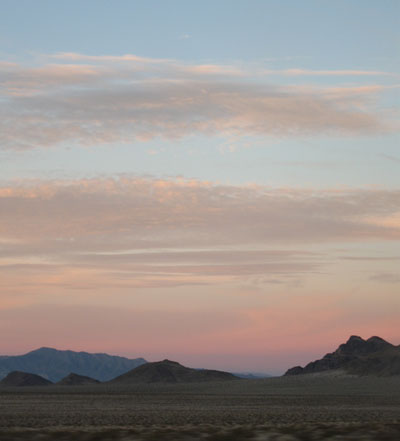
A number of solar power companies have dropped out. Others have changed their proposed projects from solar thermal to photovoltaic (which requires much less water, but also delivers less energy for the same amount of land). The limited amount of surface and groundwater in the Amargosa Valley had proven to be a limiting factor. In 2007 the Nevada state engineer outlined protections for Devil's Hole, home to a federally endangered pupfish (Cyprinodon diabolis), and "ordered that, with the following exceptions, any applications to appropriate additional underground water and any application to change the point of diversion of an existing ground-water right to a point of diversion closer to Devils Hole, described as being within a 25 mile radius from Devils Hole within the Amargosa Desert Hydrographie Basin, will be denied." Some of the exceptions are for diversions using less than 2 acre-feet per year. The wet-cooled solar thermal projects require 6 acre-feet per year.
Some companies talked of trucking in water. Hiatt laughed at this notion. He said outside solar companies do not understand Nevada water rights. All water is owned by the state. A 33% recharge is allotted to agriculture (which is present in Amargosa Desert in the form of dairies and alfalfa growers), so if a company buys 100 acre-feet of agricultural water rights, it can only receive 66 acre-feet for industrial use. There is simply not enough water.
Hiatt stood with a woman from an Oregon solar company that had applied for BLM land near Big Dune, a sandy off-road recreation area. Numerous race tracks cut through the desert floor all along the valley from the Las Vegas to Reno race. The day was windy and dust swirled through the air. Hiatt picked up an old can and a glass bottle and showed the company rep how sand-blasted it was. She took it back to her company headquarters.
Acres of glass photovoltaic panels or thermal mirrors would have to contend with "multiple use" recreation on BLM land. Mary Jo Rugwell, BLM district manager from Las Vegas, said more competing uses will conflict OHV riders with such things as solar power plants. Solar thermal mirrors need to be washed with water sprayed from a truck twice a week to remove dust.
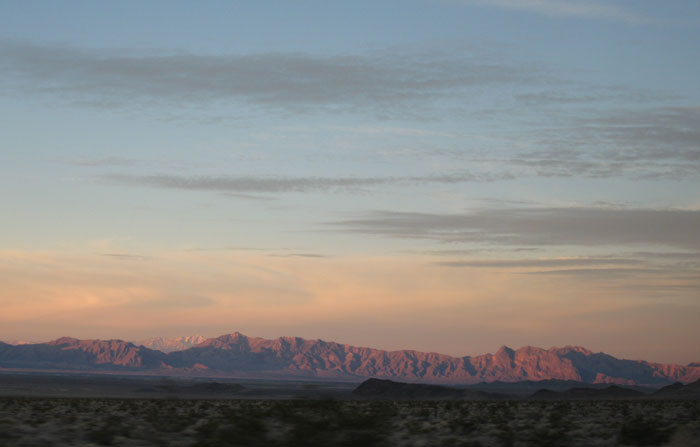
^Amargosa Desert at sunrise.
For more on this topic see the article in Pahrump Valley Times >>here.
Other Nevada Projects
Other applications for solar, wind, and geothermal projects continue to come in for other BLM lands.
Thirteen solar applications have been filed in the Tonopah BLM district in central Nevada, at places such as Mud Lake, Crescent Dunes, near Silver Peak, and near Peavine Creek. Five wind projects are proposed in the region, although Clipper Windpower pulled their test meteorological towers near the town of Goldfield (Nye County), and plans to abandon the project. The wind was not in "commercial quantities" we presume.
In the Ely BLM district of eastern Nevada: a 100 megawatt (MW) photovoltaic project on as much as 350 acres in Delamar Valley, as well as a 200 MW solar thermal "power tower" project using mirrors on 2,800 acres in the same valley. The 990 MW Wilson Creek Wind Project would use 31,000 acres of public land around Table Mountain, Atlanta Summit, and White Rock. Another wind project, 250 MW, is proposed for the Spring Valley on 16,000 acres.
HOME.....Death Valley Solar Projects
Older Amargosa Farm Road Solar Project News....Amargosa Desert
Nevada Solar 1 Solar Thermal.....New Photovoltaic Power Plant.....Renewable Energy News
